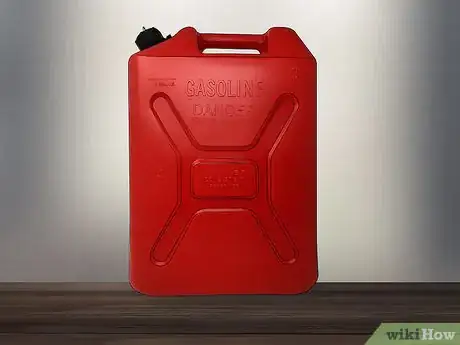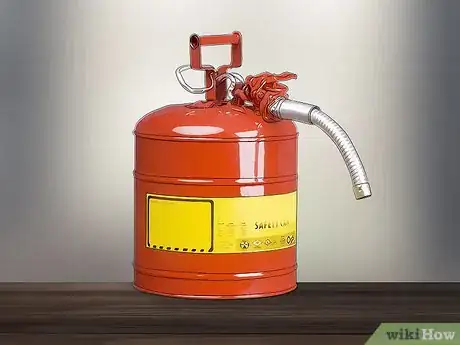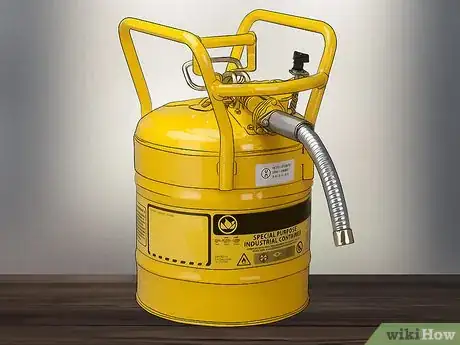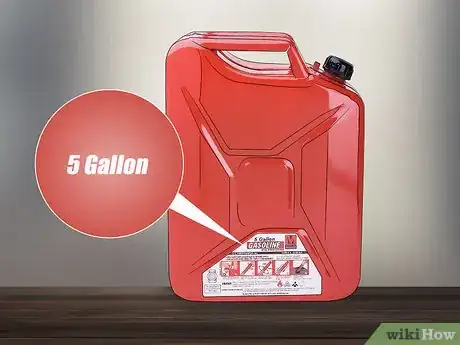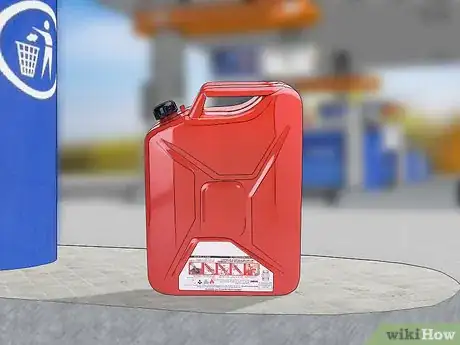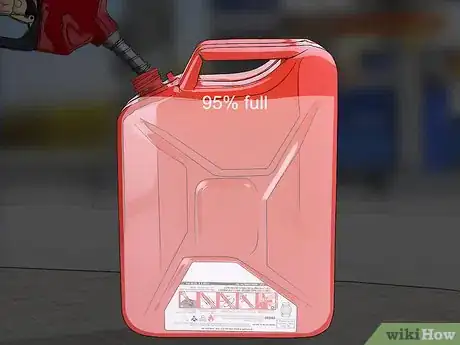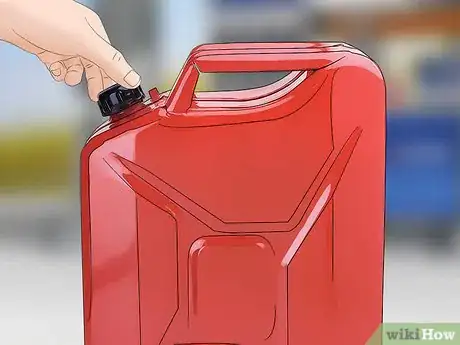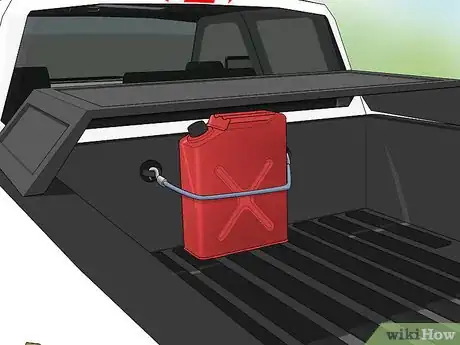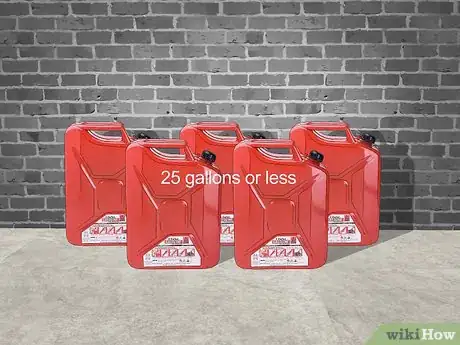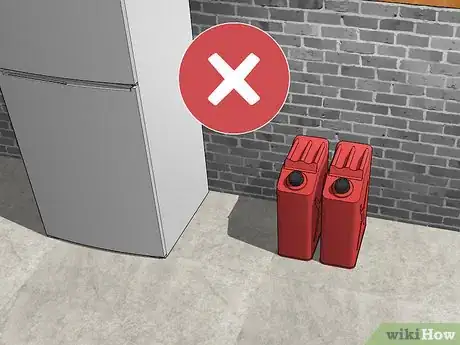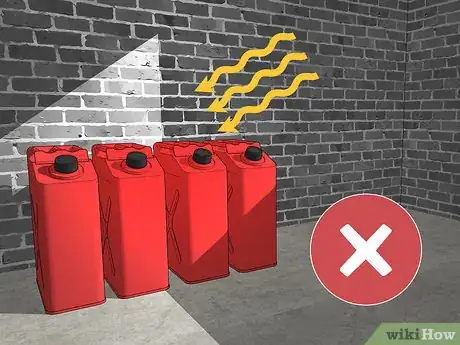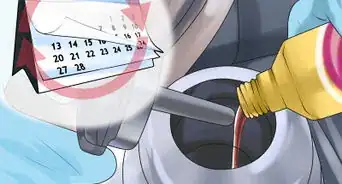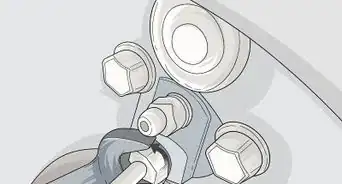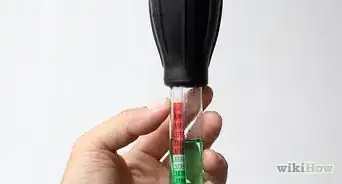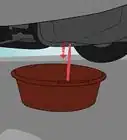This article was co-authored by wikiHow staff writer, Megaera Lorenz, PhD. Megaera Lorenz is an Egyptologist and Writer with over 20 years of experience in public education. In 2017, she graduated with her PhD in Egyptology from The University of Chicago, where she served for several years as a content advisor and program facilitator for the Oriental Institute Museum’s Public Education office. She has also developed and taught Egyptology courses at The University of Chicago and Loyola University Chicago.
There are 11 references cited in this article, which can be found at the bottom of the page.
This article has been viewed 83,308 times.
Learn more...
There are many reasons to keep gasoline around the home or workplace, from powering generators to running your lawncare equipment or even filling up your car’s gas tank in a pinch. In order to keep your gasoline safe and fresh, it’s important to store it properly. Always store your gas in safe containers specifically designed for use with gasoline. Use caution when filling and transporting your containers to minimize health and safety risks, and keep the gasoline in a safe area away from heat, fire, and electricity.
Steps
Choosing Appropriate Storage Containers
-
1Select containers that are specifically marked for gasoline. You can’t store gas safely in just any container. Look for a container that is labeled “gasoline” (or “petrol”), with appropriate warnings and information about the container’s capacity and safety features (such as spill-proof caps or flash arresting screens).[1]
- Check the label for safety certifications (such as UN/DOT or UL) or indications that the container is approved by agencies such as the Environmental Protection Agency.
- Most gasoline containers are red, which is meant to serve as a visual indicator of the flammable nature of the gas.
-
2Buy standard plastic gas cans for use around the home. For basic home use, such as filling your lawnmower or home generator, you can use the plastic gas cans available in most automotive or home supply stores. These cans are designed to meet a wide range of safety and quality standards, and are generally safe if used properly.
- Plastic consumer gas storage cans are designed to be child-resistant, leak-proof, and safe for the environment. They must meet strict national and international safety standards.
Advertisement -
3Use OSHA-approved safety cans if you’re storing gas at work. If you’re planning to store gasoline in your workplace, your containers will need to meet stricter standards than they would for home use. In the U.S., the Occupational Safety and Health Administration requires that you use OSHA-approved safety cans.[2] These cans must:
- Have a capacity of 5 gallons (19 l) or less.
- Have a built-in flash arresting screen.
- Have a spring-closing lid and spout cover.
- Be designed to relieve internal pressure safely if the can is exposed to heat or fire.
- Be approved by a testing laboratory such as Factory Mutual Engineering Corp. or Underwriter’s Laboratories Inc., or a federal agency such as the Bureau of Mines or U.S. Coast Guard.
-
4Get UN/DOT approved safety cans for use in commercial vehicles. If you need to transport gasoline containers in a commercial vehicle in the U.S., you’ll need a gas container that is approved by the Department of Transportation. The DOT approves gas containers that meet United Nations standards. These containers may be plastic or metal, and will be marked with a UN logo.[3]
- Many countries follow UN requirements for the storage and transportation of gasoline. For a detailed breakdown of the UN’s packaging and labeling standards, see Chapter 6.1 of this UN publication on the International Carriage of Dangerous Goods: http://www.unece.org/fileadmin/DAM/trans/danger/publi/adr/adr2013/English/VolumeII
-
5Choose containers with a capacity of no more than 5 gallons (19 l). While capacity requirements may vary depending on your location, most fire codes specify that portable gasoline containers should hold no more than 5 gallons (19 l) of gas.[4] In some places, there are even greater restrictions on the capacity of plastic gas containers versus metal ones.[5]
- Check your local fire code to find out about capacity regulations in your area.
Filling and Moving Your Containers Safely
-
1Keep the container on the ground as you fill it. Placing your container on the ground can help prevent gas fires caused by static electricity.[6] Never fill the container while holding it in your hand or while it is sitting in your vehicle.
- Place the container a safe distance (at least 5 ft or 1.5 meters) from your car as you fill it.
-
2Fill the container slowly and carefully. Filling your container too fast can result in splatters, spills, or a dangerous buildup of static electricity. Keep your hand on the gas nozzle at all times while filling, and make sure you are in control of the flow of gas into your container.[7]
- Always keep the nozzle of the gas pump in contact with the edge of the container opening.
-
3Stop when the container is no more than 95% full. Overfilling your container can increase risk of spills and overflow. Gasoline may expand in the container if it’s exposed to heat, so leaving a little empty space at the top is also important for preventing pressure buildup.[8]
- Some plastic gasoline containers have a strip of translucent white plastic along one side so that you can easily see how full your container is.
-
4Seal the lid tightly as soon as the container is full. Once you’re done filling your container, replace the cap and check that it is properly closed. This will prevent any dangerous leaks or spills.[9]
-
5Place the container upright in your vehicle in a shaded, stable location. Don’t put the container in your trunk or in a spot where it will be exposed to direct sunlight. Make sure the container is not lying on its side or in danger of tipping over during transport.[10]
- If you notice any splashed or spilled gas on the outside of your container, let the container sit until the gas has evaporated before you put it in your car.
-
6Remove the container from your vehicle as soon as possible. Once you’ve filled your container, take it straight to its destination and remove it from your car.[11] The interior of a car can become extremely hot. Never leave your gas sitting in your car for longer than absolutely necessary.
- Driving with a container of gas in your car also puts you at risk of illness from inhaling gas fumes, so it is best to minimize the amount of time the container stays in your vehicle with you.[12]
Keeping Your Containers in a Safe Place
-
1Store no more than 25 gallons (95 l) of gasoline in 1 room. While regulations may vary from one area to another, many fire codes specify that you cannot keep more than 25 gallons (95 l) of gas in one place. Typically, the stored gas must also be divided up into smaller storage containers.[13]
- Check with your local fire department or other health and safety authority to find out how much gasoline you can legally and safely store on your property.
-
2Keep the gasoline in a well-ventilated space away from your house. If you keep gasoline cans in your home, you run the risk of fires or exposure to fumes. Keep your containers in a shed or a specially-made flammable liquid storage cabinet outside your home.[14]
- You can buy flammable storage cabinets at many home supply stores or online.
-
3Place your containers away from major household appliances. Heat, sparks, or static electricity from appliances could ignite fumes from your gas containers. Do not store your gas container near any appliances, such as dryers, refrigerators, or water heaters.[15]
- You should also make sure that your storage area is free of any open flames or other possible ignition sources.
-
4Protect your containers from direct sunlight. Your storage area should be cool, dark, and out of the sun. Sunlight will cause your gasoline to evaporate and expand inside the container.[16]
- Too much heat from any source, including sunlight, can create a risk of fires or explosions.
- Keep your gasoline containers away from windows, and never leave them sitting outside in direct sunlight.
-
5Dispose of gasoline after 12 months or when you see signs of oxidation. If stored properly, your gasoline can potentially stay good for up to a year.[17] If your gas has been sitting in a container for a few months, pour some of it into a glass jar and look at it next to a sample of fresh gasoline. A darker color may indicate that your gas is starting to oxidize, and should be disposed of.[18]
- Adding a fuel stabilizer can extend the shelf life of your gas by a few months.[19]
- Do a search for “hazardous waste disposal facility near me” or call your local waste management agency to find out how to dispose of old gas.[20]
- Never dump gasoline outdoors or into a sink or storm drain. This can create fire risks, harm the environment, and potentially contaminate water sources in your area.
Community Q&A
-
QuestionIs a gas can supposed to be vented?
 Ryan BacigalupiCommunity AnswerYes, gas cans should be vented, as the fuel vapors expand and contract as temperature changes. With this being said, make sure to store gas away from any possible flame sources (heater, water heater, etc.) and keep away from sparks. They should ideally be stored in a well-ventilated location to prevent buildup of gas fumes.
Ryan BacigalupiCommunity AnswerYes, gas cans should be vented, as the fuel vapors expand and contract as temperature changes. With this being said, make sure to store gas away from any possible flame sources (heater, water heater, etc.) and keep away from sparks. They should ideally be stored in a well-ventilated location to prevent buildup of gas fumes. -
QuestionShould the opening on the back of the handle be open or closed?
 Community AnswerKeep it closed so nothing bad gets in. Store it with fuel stabilizer. The back vent is to remove pressure when fueling a vehicle.
Community AnswerKeep it closed so nothing bad gets in. Store it with fuel stabilizer. The back vent is to remove pressure when fueling a vehicle. -
QuestionCan you store gasoline in a milk jug for a short time?
 Vassily KniggeCommunity AnswerYou can store gas in a plastic milk jug only if you cleaned the jug out very well and let the inside dry. Then, you would only use this gas in something like a lawnmower and NOT in something like a car. This does carry a risk because gas cans have thicker plastic which can withstand more heat and are less likely to leak from the cap.
Vassily KniggeCommunity AnswerYou can store gas in a plastic milk jug only if you cleaned the jug out very well and let the inside dry. Then, you would only use this gas in something like a lawnmower and NOT in something like a car. This does carry a risk because gas cans have thicker plastic which can withstand more heat and are less likely to leak from the cap.
Warnings
- Always store gasoline in a locked storage area away from children.⧼thumbs_response⧽
- Never put gasoline in an unlabeled container or a container that is not designed for storing gasoline. It is especially important not to keep gasoline in packaging that resembles a food or beverage container.[21]⧼thumbs_response⧽
- Never pour gasoline into a hot or running engine.[22]⧼thumbs_response⧽
- Don’t leave small amounts of unused gasoline sitting around in containers. This can lead to a higher risk of explosions or fires.[23]⧼thumbs_response⧽
References
- ↑ https://www.familyhandyman.com/smart-homeowner/home-safety-tips/how-to-store-gasoline/view-all/
- ↑ https://www.osha.gov/laws-regs/standardinterpretations/2004-01-29-1
- ↑ https://www.fs.fed.us/t-d/fueltran/documents/pdf/part1.pdf
- ↑ https://www.familyhandyman.com/smart-homeowner/home-safety-tips/how-to-store-gasoline/view-all/
- ↑ http://www.hse.gov.uk/fireandexplosion/portabable-petrol-storage-containers.pdf
- ↑ http://www.parkridge.us/fire/safety_at_the_gas_pump.aspx
- ↑ http://www.parkridge.us/fire/safety_at_the_gas_pump.aspx
- ↑ http://www.parkridge.us/fire/safety_at_the_gas_pump.aspx
- ↑ http://www.parkridge.us/fire/safety_at_the_gas_pump.aspx
- ↑ http://www.parkridge.us/fire/safety_at_the_gas_pump.aspx
- ↑ http://nasdonline.org/917/d000760/storing-gasoline-and-other-flammables.html
- ↑ https://www.autoblog.com/2016/01/04/is-it-safe-to-drive-with-a-gas-can-in-your-car/
- ↑ https://www.bobvila.com/articles/how-to-store-gasoline/
- ↑ http://nasdonline.org/917/d000760/storing-gasoline-and-other-flammables.html
- ↑ http://nasdonline.org/917/d000760/storing-gasoline-and-other-flammables.html
- ↑ http://nasdonline.org/917/d000760/storing-gasoline-and-other-flammables.html
- ↑ https://www.bobvila.com/articles/how-to-store-gasoline/
- ↑ http://edition.cnn.com/2008/LIVING/wayoflife/04/09/aa.bad.gas/
- ↑ http://edition.cnn.com/2008/LIVING/wayoflife/04/09/aa.bad.gas/
- ↑ https://www.bobvila.com/articles/how-to-dispose-of-gasoline/
- ↑ http://nasdonline.org/917/d000760/storing-gasoline-and-other-flammables.html
- ↑ http://nasdonline.org/917/d000760/storing-gasoline-and-other-flammables.html
- ↑ https://www.nbcnews.com/news/world/my-gas-can-safe-flna2D11693927

